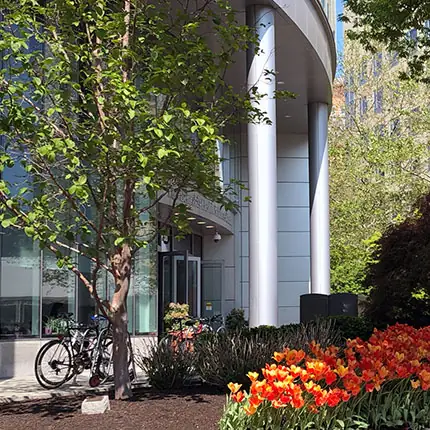Research
Currently there are no cancer prevention treatments and for many cancers there is no effective therapy. According to the International Agency for Research on Cancer World Cancer Report, more than 12 million new cancer patients were diagnosed worldwide in 2008. Cancer will be the leading cause of death in 2010.
Why is it important? There is an acute need to prevent cancer and to improve tumor rejection, thereby improving patient survival. Using a patient’s own anti-tumor T lymphocytes represents an optimal complementary cancer treatment strategy since chemo- and radiation therapies often result in eventual resistance of tumors and resulting relapses. Advances in immunotherapy may also help prevent cancer stem cells that survive conventional therapy from evading the immune system and re-populating the tumor.
Although cancer immunotherapy represents a promising approach, it has been largely ineffective for reasons that are unclear. To address these major unsolved medical problems, we are developing conceptually novel strategies of cancer prevention and cancer immunotherapy. Our aim is to eliminate the powerful hypoxia-adenosinergic mechanism that protects tumors by inhibiting incoming anti-tumor T killer cells near or within tumors. This mechanism is now recognized as a major obstacle in the tumor microenvironment, and it negates recent promising advances in cancer immunotherapy.
Currently, no existing paradigm or feasible molecular mechanism-based cancer prevention strategy eliminates small, newly-formed tumors by anti-tumor T cells. By enabling anti-tumor T cells to eliminate these small tumors, “immunogenic” cancers such as melanoma, kidney, prostate, breast, ovarian, head and neck and others may be prevented. We plan to use a strategy of anti-hypoxia-adenosinergic drugs to both i) prevent cancer in humans by preventing the inhibition of anti-tumor T cells that are trying to keep small immunogenic tumors in check in “equilibrium lesions”, and ii) enable tumor rejection by anti-tumor T cells that were either cancer vaccine-induced or adoptively transferred to the patient.
Preventing tumor protection by eliminating the powerful physiological hypoxia-adenosinergic mechanism is the unifying focus of our studies. The hypoxia-adenosinergic mechanism evolved to protect normal tissues from collateral damage by overactive immune cells. However, we have established that hypoxia-adenosinergic immunosuppression also inhibits anti-tumor T cells, thereby protecting cancerous tissue. Our strategy builds on promising insights from a previous paradigm shift which was to weaken the immunological negative regulators of T cells. In contrast, we will block both immunological and physiological inhibitors of anti-tumor T killer cells.
In contrast to the current paradigm of mainstream anticancer drug discovery, which is long and expensive, we propose using anti-hypoxia-adenosinergic drugs. These drugs are already available for other clinical indications and are known to be safe. Fortuitously, the most famous A2AR antagonist that prevents inhibition of anti-tumor T cells is 1,3,7 trimethylxanthine, a.k.a. caffeine. According to large, unbiased epidemiological studies, caffeine consumption is associated with a lower incidence of immunogenic tumors.
Putting science into clinical practice. NEITPI is in a Consortium with the Cancer Vaccine Center at Dana-Farber Cancer Institute (DFCI). Dr. Sitkovsky, who holds a joint appointment as a Presidential Scholar at DFCI, and his NEITPI scientific team are currently collaborating with scientists and clinicians at DFCI to plan clinical trials that will test anti hypoxia-adenosinergic drug therapies in conjunction with other cancer immunotherapies.
How broad is the potential impact? We may improve survival from several major cancers. Because anti-hypoxia-adenosinergic drugs are immediately available and safe, the impact may be accelerated. This mechanism-based approach may also be considered as a cancer prevention strategy for all people after a certain age who have a genetic pre-disposition. In addition, validation of this cancer immunotherapy approach may provide a novel adjuvant to improve anti-pathogen vaccines and treatments of drug-resistant bacteria.
Publications
Takayama H, Sitkovsky MV. Antigen receptor regulated exocytosis in cytotoxic T-lymphocytes. J Exp Med 1987;166:725-43.
Kincaid R, Takayama H, Billingsley M, Sitkovsky M. Differential expression of calmodulin-binding proteins in B-, T-lymphocytes and thymocytes. Nature 1987;330:176-8.
Sitkovsky MV, Paul WE. Immunology. Global or directed exocytosis? Nature 1988;332:306-7.
Ohta A, Sitkovsky M. Role of G-protein-coupled adenosine receptors in downregulation of inflammation and protection from tissue damage. Nature 2001;414:916-20.
- This paper was highlighted in 1) Putting the Brakes on Inflammation. Nat Rev Drug Discov 2002; 1,2: 99, and 2) Damping the Flames: Inflammation Control Mechanism Determined. NIH Press Release, NIH home page Dec 19 2001.
Lukashev D, Ohta A, Apasov S, Chen JF, Sitkovsky M. Cutting edge: Physiologic attenuation of proinflammatory transcription by the Gs protein-coupled A2A adenosine receptor in vivo. J Immunol 2004;173:21-4.
Thiel M, Chouker A, Ohta A, Jackson E, Caldwell C, Smith P, Lukashev D, Bittmann I, Sitkovsky MV. Oxygenation inhibits the physiological tissue-protecting mechanism and thereby exacerbates acute inflammatory lung injury. PLoS Biol 2005; 3(6):e174.
- This paper was highlighted in 1) NIH Press Release 2005, Excess Oxygen Worsens Lung Inflammation in Mice, www.nih.gov/news/pr/may2005/niaid-02.htm, 2) Science in the Death Zone, Science 2005; 308:1542 News Focus Section, and 3) Hooray for Hypoxia?, Commentary, PLoS Medicine 2005.
Sitkovsky M, Lukashev D. Regulation of immune cells by local tissue oxygen tension: HIF-1alpha and adenosine receptors. Nat Rev Immunol 2005;5(9):712-21.
Sitkovsky M, Ohta A. Caveats in promising therapeutic targeting of the anti-inflammatory A2 adenosine receptors: The notes of caution. Nat Rev Drug Discov 2006; Commentary/Opinion.
Ohta A, Gorelik E, Prasad SJ, Ronchese F, Lukashev D, Wong MK, Huang X, Caldwell S, Liu K, Smith P, Chen JF, Jackson EK, Apasov S, Abrams S, Sitkovsky M. A2A adenosine receptor protects tumors from anti-tumor T cells. Proc Natl Acad Sci USA 2006;103(35):13132-7.
Sitkovsky MV. T regulatory cells: hypoxia-adenosinergic suppression and re-direction of the immune response. Trends Immunol 2009;30:102-8

